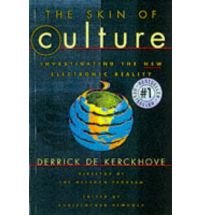Literate ears
Mike Leggett reviews Kerckhove’s The Skin of Culture
 One of the most quoted aphorisms of the century, ‘The medium is the message’, comes from Marshall McLuhan, joint founder of ‘media studies’ worldwide and anticipator of the ‘new technologies’. Derrick de Kerckhove, associate of McLuhan and now director of the Program in Culture and Technology at the University of Toronto, in his recent book, The Skin of Culture, continues to use aphorisms. Besides being economical with language they impose that moment of reflection which allows the reader to explore and extract a full meaning, if not several. Such interaction is at the core of de Kerckhove’s concern and is both the form and content of his book.
One of the most quoted aphorisms of the century, ‘The medium is the message’, comes from Marshall McLuhan, joint founder of ‘media studies’ worldwide and anticipator of the ‘new technologies’. Derrick de Kerckhove, associate of McLuhan and now director of the Program in Culture and Technology at the University of Toronto, in his recent book, The Skin of Culture, continues to use aphorisms. Besides being economical with language they impose that moment of reflection which allows the reader to explore and extract a full meaning, if not several. Such interaction is at the core of de Kerckhove’s concern and is both the form and content of his book.
The discourse covers the ‘era of television’ to the ‘Age of the Mind’ (or the collective intelligence made possible by the meeting of minds via the net). The work of various theorists and scientists, many unfamiliar but intriguingly presented, aid in the development of the description. The currently converging aspects of our technologies and systems of communication are inflected by de Kerckhove’s acknowledged expertise on language and literacy theory. The alphabet as software for the platform of Western culture is the paradigm maintained—literacy is the attendant who has strapped us into a straitjacket. Other cultural practices and beliefs are either similarly trapped or provide clues to movement for the new social architectures.
He describes, for instance, two modes of listening: “…oral listening tends to be global and comprehensive whilst literate listening is specialised and selective…Greek tragedy is nothing but the literary and dramatic response to new sensory conditions introduced by alphabetic literacy”. Similar conditions accompany every new technology, and are tracked to the present day with much extemporising on the consequences of developing world-wide telecomputers and other “psychotechnologies”. These “define any technology that emulates, extends or amplifies the powers of our minds”.
The cultural shift that comes about with a new medium marks movement away from the (literate) “private universe of mind to the public world of the cathode ray tube”. It is here that for the first time a collective intelligence is being developed and tested. It is where modes of ‘listening’ are being re-defined and he mentions the work of some ‘media’ artists, though too few—David Blair’s Waxweb project for instance—who develop in the oral tradition many of the issues raised by this book.
Empowerment and the ability to participate is raised at various points but little reference is made to the ‘psychotechnologies’ developed by the corporates through the earlier period of the ‘Age of Information’ and which were, and remain, significantly participatory—8mm film, sound recording, video and more recently the handycam and snapshot photography phenomenon. Practised at a popular and artisanal level these recent mediums might have provided illustrative as well as evidential material.
Maybe it is De Kerckhove (or this reviewer), who is happiest with the sections that communicate in the ‘literate’ tradition. Besides various cognitive aspects of ourselves, topics also include an insight into Japanese culture, and a description of the bogey-world of neural nets. As a long-time and frequent visitor to Japan he usefully describes the phenomenon of ma, which “connotes the complex network of relationships between people and objects”. Based on analogue rather than digital processes, these nets respond to a range of values, rather than the binary values which characterise the digital computer, and mimic the human brain’s skill at comparing patterns of interconnections between thousands of sets of variables. The series of interconnected neurodes or receptor/decision points adapt and learn. Already neural nets have many industrial applications and move ever closer to the HAL machine of Kubrick’s 2001.
De Kerckhove suggests that we “create political mechanisms to protect universal access and freedom of expression as well as right to privacy on the net”, having established a few pages earlier that as an organic, self-organising entity, “Our obsolescent political notions are going to be thoroughly trashed by it”. The creation of many such mechanisms are long overdue—and we are yet again confronted with the option of the commune. De Kerckhove’s general optimism may overcome, but he advocates ‘business’ as the ‘collective mind’ to determine and build the wired world he clearly favours. In support of this notion we should remember that it is a commercial computer network operator that the German government has recently made moves on in order to restrict access to the internet’s vociferous newsgroups.
Ironic that it was a German, Georg Lichtenberg, who in developing the art of the aphorism in the 18th century devised one which the advocacy associated with the McLuhan Program would appreciate: “There are many people who won’t listen until their ears are cut off”.
In his book De Kerckhove addresses the psychological and cultural most convincingly—by directing us away from the prescriptive of the literate ear and towards the associative of the oral ear—again with another aphorism: “Our neglect of the ear may be one of the prices we have paid for literacy”.
Derrick de Kerckhove, The Skin of Culture: Investigating the New Electronic Reality, Somerville House Publishing, Toronto. ISBN 1-895897-45-9 Pbk
RealTime issue #11 Feb-March 1996 pg. 24






